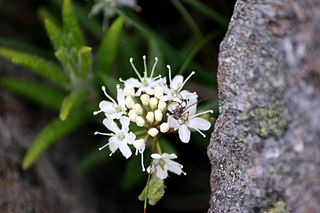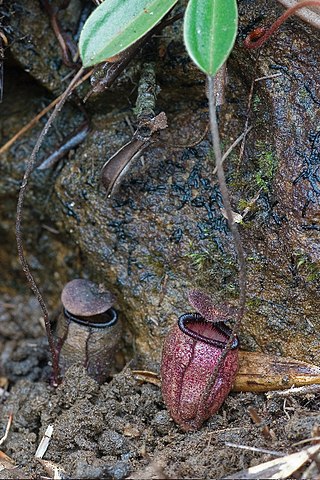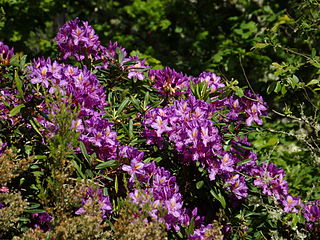
Rhododendron is a very large genus of about 1,024 species of woody plants in the heath family (Ericaceae). They can be either evergreen or deciduous. Most species are native to eastern Asia and the Himalayan region, but smaller numbers occur elsewhere in Asia, and in North America, Europe and Australia. It is the national flower of Nepal, the state flower of Washington and West Virginia in the United States, the state flower of Nagaland in India, the provincial flower of Jiangxi in China and the state tree of Sikkim and Uttarakhand in India. Most species have brightly colored flowers which bloom from late winter through to early summer.

Labrador tea is a common name for three closely related plant species in the genus Rhododendron as well as an herbal tea made from their leaves.

Sir George Watt was a Scottish physician and botanist who worked in India as "Reporter" on economic botany and during the course of his career in India he compiled a major multivolume work, TheDictionary of Economic Products of India, the last volume of which was published in 1893. An abridged edition of his work was also published as the single volume Commercial Products of India in 1908. He is honoured in the binomials of several plants named after him.

Nepenthes sibuyanensis is a tropical pitcher plant endemic to Sibuyan Island in the Philippines, after which it is named.

Nepenthes argentii is a highland Nepenthes pitcher plant native to Mount Guiting-Guiting on Sibuyan Island in the Philippines. It is possibly the smallest species in the genus and does not appear to have a climbing stage.

Rhododendron ponticum, called common rhododendron or pontic rhododendron, is a species of Rhododendron native to the Iberian Peninsula in southwest Europe and the Caucasus region in northern West Asia.

Rhododendron catawbiense, with common names Catawba rosebay, Catawba rhododendron, mountain rosebay, purple ivy, purple laurel, purple rhododendron, red laurel, rosebay, rosebay laurel, is a species of Rhododendron native to the eastern United States, growing mainly in the southern Appalachian Mountains from Virginia south to northern Alabama.

Rhododendron maximum — its common names include great laurel, great rhododendron, rosebay rhododendron, American rhododendron and big rhododendron — is a species of Rhododendron native to the Appalachians of eastern North America, from Alabama north to coastal Nova Scotia.

Wildlife diversity is a notable feature of Nepal. Because of the variance in climate, from tropical to arctic, Nepal has a large variety of plants and animals. Wildlife tourism is also a major source of tourism in the country. There are some animal species which are unique to Nepal, such as the spiny babbler. Nepal is also host to many rhododendron species. The wildlife of Nepal includes its flora and fauna. Nepal has established numerous national parks and reserves in order to protect its diverse fauna. Nepal is a biodiversity hot spot with ecoregions broadly comprising the mountainous ecoregion, the savanna and grasslands ecoregion of the terai (foothills), and the Rara Lake ecoregion, which has many endemic species.

Rhododendron lochiae is a species of plant in the family Ericaceae, and is one of only two species of the genus Rhododendron that are native to Australia. It is found only in restricted areas of mountain–top cloud forest habitats within the Wet Tropics of Queensland World Heritage Site. The other species, Rhododendron viriosum, was only formally classified as a separate species in 2002.
Erythrina schliebenii is a species of legume in the family Fabaceae. It is found only in Tanzania. The species is named for German collector and botanist Hans-Joachim Schlieben.
Vidumelon wattii is a species of land snail in the family Camaenidae. It is known commonly as Watt's land snail. It is endemic to Australia, where it is limited to a range no more than 10 kilometers wide located near Alice Springs.
Rhododendron album is a species of plant in the family Ericaceae. It is endemic to Java in Indonesia. It is a vulnerable species threatened by habitat loss.
Rhododendron fictolacteum is a species of plant in the family Ericaceae. It is endemic to China.

Rhododendron kanehirai is a species of plant in the family Ericaceae. It was originally endemic to Taiwan. It has become extinct in the wild, though it still exists in cultivated form.
Rhododendron subansiriense is a species of flowering plant in the family Ericaceae, endemic to the Subansiri district of northeastern India. Growing to 14 m (46 ft) in the wild, it has dense trusses of red flowers spotted with purple.

Rhododendron selense (多变杜鹃) is a rhododendron species native to southwestern Sichuan, eastern Xizang, and western Yunnan in China, where it grows at altitudes of 2,700–4,000 m (8,900–13,100 ft). It is an evergreen shrub that grows to 1–2 m (3.3–6.6 ft) in height, with leaves that are oblong-elliptic or obovate to elliptic, 4–8 by 2–4 cm in size. The flowers are pink.
Psylliodes luridipennis, commonly known as the Lundy cabbage flea beetle or the bronze Lundy cabbage flea beetle, is a species of flea beetle endemic to the island of Lundy, where it lives and feeds upon the endemic Lundy cabbage. Along with the true weevil Ceutorhynchus contractus var. pallipes and an undescribed race of flea beetle Psylliodes napi, it is known only from the Lundy cabbage. The species was first recorded by Thomas Vernon Wollaston in the 1840s, and was named by the Austrian entomologist Franz Kutschera in 1864.

The Wondiwoi tree-kangaroo is a critically endangered, bear-like mammal native to tropical mountain forests on the island of New Guinea. Elusive and rare, it was considered extinct until rediscovery in 2018. It is a species of tree-kangaroo, a group of long-tailed, bear-like animals native to Australia and New Guinea that mostly live in trees and feed on plant matter. Tree-kangaroos belong to the macropod family (Macropodidae) with kangaroos, and carry their young in a pouch like other marsupials. The Wondiwoi tree-kangaroo is likely threatened by hunting, and is known only from remote mountains on the Wondiwoi Peninsula in northwest New Guinea.

Kobuleti Strict Nature Reserve is a protected area in Kobuleti Municipality, Adjara region of Georgia along the Black Sea coast in the northern part of the resort town Kobuleti. Kobuleti Protected Areas were established in 1998 to preserve unique wetland ecosystems recognized by the Ramsar Convention. Because of these wetland ecosystems, ancient forests, and the high biodiversity found within the reserve, it was inscribed on the UNESCO World Heritage List as part of the Colchic Rainforests and Wetlands in 2021.














